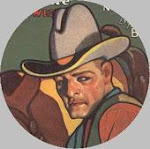The Long Haul, by Antony Johnston (script) and Eduardo Barreto (art),
brings together the caper story with the western in a nice addition to
the small world of western comics. I say small world, because once
upon a time — I’m thinking the 1940s and ‘50s here — there were probably
as many different western comic book titles as there were superhero,
adventure, and other genre titles published by a variety of companies,
all vying for space on the newsstands. Nowadays, only two continuing
western title comes to mind — DC Comics’ Jonah Hex and Dynamite’s Lone
Ranger — although there may be a handful of others that may be currently
appearing of which I’m unaware, because I rarely venture into comic
shops these days.
The Long Haul is a one-shot graphic novel published by independent Oni
Press in 2005. Its 174 pages are smaller in format than the typical
comic book, but it looks like it was created specifically for the
graphic novel format instead of being compiled from a series of issues
published separately, as most graphic novels from DC and Marvel are
typically collections, not novels.
The Long Haul is set in 1871. It tells us about the efforts of bank
robber and roguish ladies man Cody Plummer to recruit a gang to rob a
train carrying $1.9 million in government bonds from Chicago to San
Francisco. Plummer also is hounded by a Pinkerton agent, Bob Harding,
who is sure the robber is up to no good.
Antony Johnston is a British writer of comic books, novels, video
games, and more for a variety of publishers, and he handles what is
traditionally considered a U.S. genre very convincingly. (The Brits
have given the world lots of renown western work, including the Edge
and Steele series among other Piccadilly Cowboy series; and Hale
Publishing continues its Black Horse Western imprint with six or more
novels released each month.)
Artist Eduardo Barreto hails from Uraguay, but his work has appeared
for many years in a variety of DC Comics. He seems to have adapted his
style a bit for this black-and-white presentation by employing solid
blacks and dropping outlines for dramatic effects in ways that remind
me of how Alex Toth — a master of the black-and-white narrative
arts — would employ black shadows in a composition. He also uses
judicious placement of cross-hatching for a scrumbling effect or to
suggest textures, which recalls some of John Severin’s stylistic
touches in his western- and war-comics work.
The story has a nice flow and pacing, and the script and artwork
complement each other nicely. Thumbs up to both men for this diverting
story.
Sunday Morning Bonus Pulp: Sky Raiders, April 1940
10 hours ago





